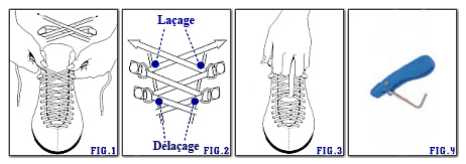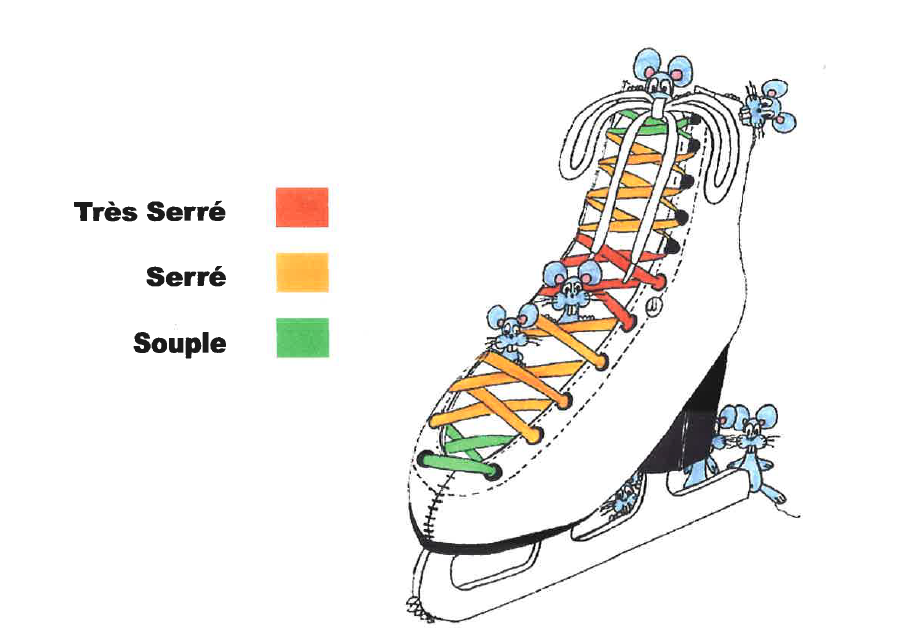Skates
Skates are a skater's only tool. Therefore, it is important to know how to chose them with care and how to maintain them correctly. The skates must NOT have velcro buckles or straps. The skates must only use laces.
Choice of skate size: It is important to choose skates of the right size. Avoid buying one size too big under the pretense that the skater will keep growing; a poorly adjusted pair of skates is a source of discomfort and discouragement and produces negative results.
Lean to Skate Fit Guide: Skate selection is based on Level and weight of the skater. For example in the Jackson Skate line. Softec skates are meant for seasonal and leisure skaters who want the enjoy the sport as a social or infrequent activity. They are not supportive enough to learn the basics of skating.
Below is an example of the difference in skate selection based on level and weight of the skater.
| LEVEL | LT 40 LB/20 KG | 20-80 LB / 20-40 KG | MT 80 LB/40 KG |
| CanSkate 1-2 | 450 Series / Excel | Excel | Excel / Mystique |
| CanSkate 3-5 | Excel | Excel / Mystique | Excel / Mystique/ Artiste/Evo |
|
CanSkate 6 / STAR 1-2 |
Excel/Mystique/ Artiste/Evo | Mystique/ Artiste/Evo/Elle | Artiste/ Evo/ Elle |
| Example of boot Stiffness - Jackson line | |||||
| 450 Series | Excel | Mystique | Artiste | Evo | Elle |
| 15 - 20 | 20 - 30 | 30 - 45 | |||
Firmly supported ankles: When skating, it is essential for the ankles to be well supported by the skates. For this to be possible, the skates must be well adjusted at the ankle and the heel, all while allowing to move the toes. The skates must be laced as to allow the skater to move their toes and the tip of their toes all while properly holding the ankle properly. It is important not to tighten the toes too much, but to tighten the ankle and the instep properly.
The laces should be held in place solidly and they should be tight enough as to barely fit one finger behind the foot at the top of the boot. They should also be long enough for a double knot to be tied. It is important not to wrap the laces around the ankle. Furthermore, for the skater to be at ease in his skates, there should be no wrinkles on the inside of the boot. The strip must be properly stuffed and large enough to cover the front of the ankle and to stay in place.
Skates that hug the foot or skates attached with Velcro straps harm the learning of a proper skating technique. These skates are not recommended. Furthermore, plastic skates lack flexibility to the point where it can be hard for the person wearing them to bend their knees in order to give themselves a starting push. Finally, as plastic gets very cold and very hard on the ice, these skates make the wearers feet very cold. It is therefore recommended to choose leather boots (not vinyl), since they have the necessary flexibility to skate comfortably.

Skate maintenance:
- Sharpen new skates as soon as they are bought.
- Wipe the blade of the skate properly after each use, to prevent rusting and to make sharpening easier.
- Always wear skate guards when walking with skates on (between the room and the rink).
- Never leave skate guards on the skates between training sessions (humidity in the skate guard creates rust).
- It is preferable not to leave skates in the trunk of your car to prevent rust from forming.
- Sharpen skates again after about 30 hours of skating.
Lacing skates:
Before putting skates on, unlace them and lift the strip in oreder for the foot to go inside. Slip the foot into the boot. Make sure that there are no creases in the tights. Verify that the heel of the foot touches the back of the boot and that the toes move freely. If not, loosen the boot and put the foot back in. To tie the skates, away start at the bottom. All of the laces must be tight. The skater must feel and equal force around his foot and not only on the side. The toes should move freely. The most important thing is to keep the ankle well supported for a good balance.





